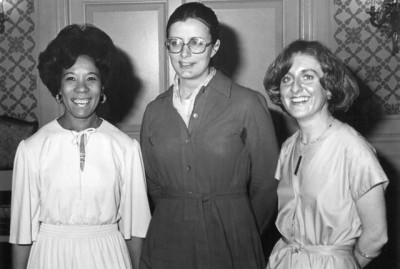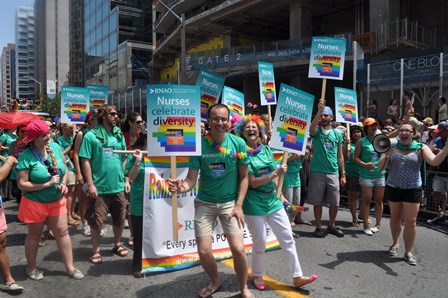The Registered Nurses’ Association of Ontario (RNAO) is celebrating its 90th anniversary during 2015. In a series of articles in its bimonthly publication, Registered Nurse Journal, the association looks back at some of its milestone moments over the past nine decades. This excerpt illustrates its work on diversity, a matter that has shaped the profession and the association’s work.
The Registered Nurses’ Association of Ontario (RNAO) had only just celebrated two decades of existence when black women in Canada were finally allowed to go to school for nursing. It was the late-1940s, and Jocelyn Hezekiah hadn’t yet reached her 10th birthday. She wasn’t thinking about a career in nursing…yet. Fast forward three decades and Hezekiah, who hails from Trinidad, would find herself at the helm of the provincial organization representing registered nurses, assuming the role of the association’s first president from a cultural minority.

Nursing Pulse.jpg: Jocelyn Hezekiah (left) was president-elect of RNAO in this image from
the 1977 annual general meeting. Maureen Powers (centre) and Irmajean Bajnok (right) were executive director and president, respectively.
She reflects back and remarks candidly that racism was not a pressing issue for RNAO in the late 70s. “It may very well have been there, but it wasn’t on the front burner,” she recalls. In fact, it wouldn’t come to the forefront for another decade.
Former public health nurse and long-time RNAO member Daphne Bailey, who (like Hezekiah) studied nursing and midwifery in the U.K., arrived in Canada in 1960. She says she was “lucky” to work as a nurse for decades without feeling the direct impact of discrimination. Originally from Jamaica, Bailey was so happy to be in the role she dreamed about as a child that she didn’t concern herself with cultural differences. “I just look at people as people,” she explains. “That interests me more than skin.”
MORE: FROM NURSING TO POLICING AND BACK AGAIN
Hezekiah concurs, but acknowledges, as does Bailey, that discrimination was a reality for some of their colleagues.
In the early 1990s, a group of seven black nurses at Toronto’s Northwestern General Hospital (now Humber River Regional Hospital) took their claims of discrimination and exclusion to the Ontario Human Rights Commission (OHRC). The nurses said that “…access to professional development and training, shift assignments, disciplinary actions and promotions were based on racial factors, and that (Caucasian) nurses received preferential treatment,” according to historical documentation from the Ontario Nurses Association (ONA). They also complained the hospital had refused to support them when they were abused and harassed by patients and their families.
In 1994, OHRC ruled in favour of the nurses and “…the hospital agreed to pay $320,000 and to take steps to ensure a racism-free workplace,” according to ONA.
The ruling was a turning point in discussions about racism in the health care sector, says Rani Srivastava, who was elected to RNAO’s board of directors in 2000. And “…it was a huge catalyst for me getting involved…” in the association, she adds. When she heard then-RNAO President Kathleen MacMillan speak publicly about the case in 1994, and the need for health-care organizations to take a closer look at their processes with an anti-racism lens, Srivastava, whose cultural background is southeast Asian, remembers being pleased that an RNAO nursing leader was touching on an issue that she was very aware of on a personal level. “I would go to RNAO meetings and…people didn’t look like me,” Srivastava says
After the OHRC decision, provincial funding was allocated to create pilot projects that would tackle issues of racism. Hospitals, including the one where Srivastava worked at the time (Wellesley Central Hospital, now closed), applied for grants and launched anti-racism projects. Srivastava, now chief of nursing and professional practice at Toronto’s Centre for Addiction and Mental Health, knew she wanted to be a part of that change.
She shared that desire with other RNs who were joining the RNAO board at the same time. Joan Lesmond was one of them.
Originally from St. Lucia, Lesmond became the association’s second black president in 2002. During her tenure – and as a top priority – RNAO formalized its anti-racism policy that was first drafted under MacMillan’s leadership in the late 90s. The board also worked to define what it truly means to respect diversity and to promote inclusivity
Gurjit Sangha, who was born in Canada but whose parents came from India, represented Region 6 on the board at that time, and recalls two important things about Lesmond’s legacy. The first was the anti-racism policy, which was formalized in 2002. The association committed to “…an environment where all nurses and clients are treated with dignity and respect, and where diversity is valued
“I think seeing her as leader of the organization made people think ‘how is it that RNAO can attract someone like Joan Lesmond?’” Sangha says, suggesting Lesmond’s presidency led members who may not have felt represented to think “…there must be something there that’s going to appeal to us and something important to us.
RNAO is a reflection of what is going on in the broader community, Hezekiah suggests, and people started talking openly about diversity and inclusivity at the turn of the century. Lesmond, who succumbed to cancer in 2011, was a trailblazer in this regard, and was keenly aware of the importance of having the profession of nursing reflect the diversity of the population
In an interview before taking the helm, she said: “Above all else, my fundamental belief in the basic value of respect for all people and a willingness to learn precedes all else and is the foundation on which I will build my presidency.” She went on to lead the launch of RNAO’s Embracing Diversity Initiative, suggesting that through that work, RNAO had an opportunity “…to show leadership in a meaningful manner by…defining what diversity and inclusivity mean in practical and symbolic terms.” She called on nurses to “…own this issue, and inform it.”
Acknowledging that discrimination is not only about race, RNAO began advocating against marginalization of other populations, and in particular, people who are transgender, including those who identify as transsexual. In 2007, the Rainbow Nursing Interest Group (RNIG) was formed to advance lesbian, gay, bisexual, and transgender (LGBT) inclusivity in education, research and the workplace.
RNAO participates each year in festivities across the province to mark World Pride, including Toronto’s Pride Parade, and submissions to government on issues of gender equality are ongoing. In 2012, the association presented to the standing committee on social policy regarding Bill 33, Toby’s Act, which called for the right to be free from discrimination and harassment because of gender identity or gender expression.
MORE: RN RESEARCHER HELPS MARGINALIZED POPULATIONS
RNAO took a stand because all discrimination “…erodes health through increased risk of violence, poverty, and social exclusion, diminishes access to health care, and threatens quality work environments,” CEO Doris Grinspun told the committee.
“I think it’s fantastic we’re paying attention to gender and sexual orientation…there’s lots of things that marginalize people in groups,” Srivastava says. “I think the groups you focus on change over time, but I think what you don’t want to lose sight of is the over-arching principles.”
RNAO considers diversity and inclusivity in so much of its work, Grinspun says, and Srivastava agrees. “We haven’t lost that.”




